Zhejiang University
Zhejiang University (ZJU; 浙江大学) is a public university in Hangzhou, Zhejiang, China. The university is affiliated with the Ministry of Education. It is part of the Double First Class University Plan, Project 985, and Project 211.
 | |||||||
Other name | ZJU or Zheda | ||||||
|---|---|---|---|---|---|---|---|
Former name | Chekiang University National Chekiang University | ||||||
| Motto | 求是创新[1] | ||||||
Motto in English | Seeking Truth and Pursuing Innovation[2] | ||||||
| Type | Public | ||||||
| Established | 1902 | ||||||
Academic affiliations | C9, APRU, WUN, IAU, GUNi, YDUA, BRICS Universities League | ||||||
| Budget | CN¥ 26.1 billion (2022) | ||||||
| President | Du Jiangfeng | ||||||
| Party Secretary | Ren Shaobo | ||||||
Academic staff | 4557 | ||||||
| Students | 65,821[3] | ||||||
| Undergraduates | 29,117 | ||||||
| Postgraduates | 36,704 | ||||||
| Location | , China 30°15′49″N 120°07′15″E | ||||||
| Campus | 622 hectares (1,540 acres) | ||||||
| Academic term | Semester | ||||||
| Colors | Blue & red | ||||||
| Mascot | Qiushi Eagle 求是鹰[4] | ||||||
| Website | zju.edu.cn zju.edu.cn/english | ||||||
 | |||||||
| Chinese name | |||||||
| Simplified Chinese | 浙江大学 | ||||||
| Traditional Chinese | 浙江大學 | ||||||
| Postal | Chekiang University | ||||||
| |||||||
The university holds 7 faculties, 37 colleges, schools, and departments, offering 140 undergraduate and 300 graduate programs.[5] The university also has seven affiliated hospitals, 1 museum, and 2 international joint institutes.[6] The university is a member of the C9 League.
History
In 1927, the Nationalist Government occupied Hangzhou through the Northern Expedition and established the Third National Sun Yat-sen University (国立第三中山大学) on the current site of Zhejiang University. The number of students was 174.
In April 1928, the Third National Sun Yat-sen University was renamed the Republic of China Great Academy Chekiang University (中华民国大学院浙江大学). On July 1 of the same year, the word "national" was added to the name of the school and it was named "National Chekiang University." Jiang Menglin and Shao Peizi successively served as principals. They founded a liberal arts college, expanded the university campus, and planted farms. By 1936, there were three colleges: liberal arts, engineering, and agriculture.
In April 1936, Chiang Kai-shek appointed Zhu Kezhen as the president of National Chekiang University, and agreed to Zhu Kezhen's terms of office: "Financial resources must be continuously provided, and the president shall have full power in appointing people without interference from the Kuomintang."

On July 7, 1937, the July 7th Incident announced the beginning of the all-out Anti-Japanese War, and the war soon spread to Zhejiang. In November of the same year, under the instruction of Chiang Kai-shek, President Zhu Kezhen of National Chekiang University led all the teachers, students, staff, and some of their family members, and began to move westward. The school first moved to Tianmu and Jiande in West Zhejiang; then to Ji'an and Taihe in Jiangxi; and for the third time to Yishan in Guangxi. The school arrived in Guizhou in January 1940. It continued to operate for 7 years until the victory of the Anti-Japanese War in 1945.
On May 3, 1949, the Chinese People's Liberation Army liberated Hangzhou from the Kuomintang. On June 6, the Chinese People's Liberation Army Hangzhou Municipal Military Control Commission decided to implement a military takeover of National Chekiang University and sent military representative Lin Hujia and deputy military representative Liu Yifu to the school to take over the university. In September, the Department of Agricultural Economics of the Private Nantong University College of Agriculture was merged into Chekiang University.[7]
In October 1950, the Central People's Government of the People's Republic of China ordered universities nationwide to remove the words "national," "provincial," and "municipal" from their school names. National Chekiang University changed its name to Chekiang University.
In 1958, by the standardization of Chinese pinyin system, the university changed its name to Zhejiang University.
On September 15, 1998, then Zhejiang University, then Hangzhou University, then Zhejiang Agricultural University, and then Zhejiang Medical University merged to form the current Zhejiang University.[7]
Campuses
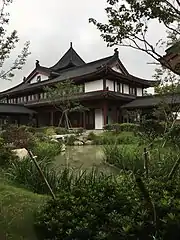
Current campuses
With seven campuses, namely Zijingang, Yuquan, Xixi, Huajiachi, Zhijiang, Zhoushan, International campus in Haining and Ningbo, Zhejiang University encompasses an area of 6.22 square kilometers with school buildings covering 3.67 million square meters of floor space.
Zijingang Campus

Zijingang campus serves as the main campus of Zhejiang University and is located in the northwest of Hangzhou. There are two libraries in the campus, i.e. the Basic Library next to the east gate and the Library of Agriculture and Medicine in the southeast corner and Library of Ancient Books in the south of the campus. The first floor of the Basic Library is an English corner every Tuesday and Thursday night.[8] The campus is served by Sanba Station and Xialongwei Station of the Hangzhou Metro to the east of the campus and Zijingang Campus Zhejiang University Station on the south side.[9]
The South Gate of the campus is linked to the Zijingang Campus Zhejiang University station with bridges over the Yuhangtang River, which were opened in February 2022.[10] The gigantic, five-arched South Gate was built with donations from alumni, but widely regarded unfit for the purpose among ZJU students.[11] In a public poll in 2021, the South Gate was voted as the ugliest building in China.[12][13]
Zijingang Campus boasts a large assortment of academic departments and schools, including College of Media and International Culture, School of International Studies, School of Art and Archaeology, School of Economics, College of Education, College of Pharmaceutical Sciences, School of Medicine, College of Chemical and Biomedical Engineering, College of Biosystems Engineering and Food Science, College of Animal Sciences, College of Life Sciences, College of Civil Engineering and Architecture, College of Environmental and Resource Sciences, School of Management, and School of Public Affairs etc.

Yuquan Campus
Yuquan campus is the campus of engineering, computer science, and the physical sciences. Most students at the Yuquan campus are graduate students within these academic disciplines. The Yuquan campus was the main campus of Zhejiang University until the Zijingang campus was built in 2002. The campus is served by the Gudang and Huanglong Sports Center stations of the Hangzhou Metro.
Zheda Road that stretches from the main gate of the campus to the High School Attached to Zhejiang University was known for its road greening landscape design.[15] Alongside the road is a compound named Zheda Qiushi Village, also known as Qiushi Village, which was the residential area for Zhejiang University faculty and their family. Qiushi Primary School, also known as the Primary School Attached to Zhejiang University, and Hangzhou No. 15 Middle School, also known as the Junior High School Attached to Zhejiang University, are located near the compound.[16] The Yuquan 1897 cafe within the campus is an English corner every Wednesday evening.[8]
Xixi Campus
Xixi campus was previously the site of the former Hangzhou University before it merged into Zhejiang University in 1998. The campus hosts Department of Psychology and Behavioral Sciences, School of Art and Archaeology, and Zhejiang University Press. The library is located in the Center of campus. Between the library and the south gate of the campus is a large meadow. The campus is next to Xuejun High School. Xuejun used to be the affiliated high school of Hangzhou University, and is among top two high schools in Hangzhou, hence a major source of students admitted into Zhejiang University. Due to the location, the university canteen at Xixi was often overloaded with high school students.[17]
Huajiachi Campus
The Huajiachi campus was previously Zhejiang Agricultural University before merging with Zhejiang University and served as the old Huajiachi Campus for the National Chekiang University before the early 1950s.[18] The campus is home to the departments of dentistry and agriculture, plus the College of Continuing Education. The Huajiachi campus is Zhejiang University's oldest campus. The Huajiachi initially refers to a lake within the campus, hence the name of the campus. The library is located on the east shore of the Huajiachi. The university made a plan to move out from the campus in 2007. As part of the plan, one fourth of the campus had been sold in 2013. In the plan, the campus will be transformed into a lakeside park that reserves most of the campus' old buildings.[18][19]
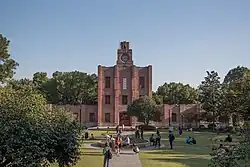
Zhijiang Campus
The Zhijiang campus (simplified Chinese: 之江校区; traditional Chinese: 之江校區) is home to Guanghua Law School. Before being acquired by Zhejiang University in 1952, the Zhijiang campus served as the main campus of Hangchow University, and is located on the Yuelun Hill next to the Qiantang River and the Liuhe Pagoda. The campus is now home to James D. Watson Institute of Genome Sciences, Guanghua Law School and the Institute for Advanced Study in Humanities and Social Sciences.[20] The Library of Guanghua Law School is located to the north of the Main Teaching Building. Several buildings in the campus are listed as the Major Historical and Cultural Sites Protected at the National Level.[20] The 2010 movie Aftershock made the campus a popular tourist destination within the city, as the movie was shot on location within the campus to mimic a Chinese university life in the 1980s.[20]
Zhoushan Campus
Zhoushan campus (simplified Chinese: 舟山校区; traditional Chinese: 舟山校區) is a campus that opened in 2015 and serves as the campus for the Ocean College. It is located in Lincheng, Dinghai District, Zhoushan City on the Zhoushan Island.[21] The Library of the Ocean College is located in the north of the campus. Between the library and the south gate is a meadow. The university's only training ship, named Zijingang, is deployed at the campus.[22] Only third-year and fourth-year undergraduate students of the Ocean College and postgraduate students studied at the campus, while first-year and second-year students of the college receive education at Zijingang before moving to the campus in their third year.[21]
Haining International Campus
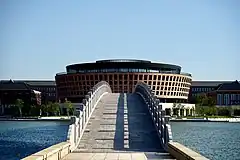
Haining International Campus (simplified Chinese: 海宁国际校区; traditional Chinese: 海寧國際校區) is located in the Zhejiang city of Haining.[23] Clusters of international cooperative partners and institutions reside at this campus, which opened in 2016 as part of Zhejiang University.[24][25] Student studying at the campus are also enrolled in the residential college. The first master of the college is Professor Lap-Chee Tsui.[26][27][28] The International Campus Library is a three-storey octagonal building located on the northeast shore of the central lake of the campus.[29] The campus is served by International Campus, ZJU station of Hangzhou–Haining intercity railway,[30] which opened on 28 June 2021.[31][32]
Zhejiang University International Business School (ZIBS),[33][34] the Zhejiang University-University of Edinburgh Institute (ZJE),[35][34] the Zhejiang University-University of Illinois at Urbana-Champaign Institute (ZJUI) and the Imperial College-Zhejiang University Joint Applied Data Science Lab are located within the campus.[36][34]
Ningbo Campus
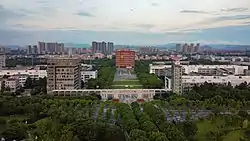
The Ningbo campus was initiated as a collaboration with Ningbo city government in September 2017, with the campus' administration founded in September 2019. It was based on the campus of the former Ningbo Institute of Technology (NIT) of Zhejiang University (now NingboTech University). Zhejiang University library has not set up a branch library in the campus, yet its resources are available at NingboTech's library. The campus is served by South Higher Education Park Station of Ningbo Rail Transit.[37] The Polytechnic Institute of Zhejiang University started a branch in the campus since October 2016. Later, the Institute of Ningbo was founded in June 2018 within the campus of Ningbo Institute of Technology (NIT), Zhejiang University. In January 2020, the NIT was made independent from Zhejiang University and renamed as NingboTech University, but remains in the campus. The campus is also home to the School of Software Technology, Zhejiang University.[38][39]
Off-campus research Centers
The university also has several research institutes off its campuses within Zhejiang, which include the Innovation Institute for Artificial Intelligence in Medicine,[40] Zhejiang University Innovation Institute International,[41] Innovative Institute of Basic Medical Sciences of Zhejiang University[42] in Hangzhou, the Institute of Wenzhou,[43] Research Institute of Zhejiang University – Taizhou,[44] Institute of Quzhou,[45] Institute of Jinhua,[46] Institute of Huzhou,[47] International Institutes of Medicine in Yiwu,[48] the Institute of Shaoxing,[49] and the Ocean Research Center of Zhoushan.[50]
The institutes and research Centers outside the province include the Institute of State System Research (Beijing Research Center),[51] Shanghai Institute for Advanced Study,[52] Hainan Institute of Zhejiang University,[53] the Institute of Shenzhen,[54] Suzhou Industrial Technology Research Institute,[55] and Changzhou Industrial Technology Research Institute,[56] and Zhongyuan Institute in Zhengzhou.[57]
Wartime Campuses
During the World War 2, the university left its campus in Hangzhou to evade Japanese invasion. During the wartime relocation, the university also temporarily used the campuses in Jiande in 1937, Ji'an, Taihe Yishan in 1938, before it finally arrived in Meitan and Zunyi, Guizhou in southwest China in early 1940. The university operated there for seven years until the war ended. In June 1939, the university set up a satellite campus headed by Zheng Xiaocang in Longquan, Zhejiang.[58]
In 2016, Dr. Ye Yongfei of the central committee of the Revolutionary Committee of the Chinese Kuomintang suggest that the university restore the Meitan campus to support economic development in western China, which was echoed by the local government of Zunyi who set up a committee to gather support in 2018. In March 2018, the university responded that it had no substantial plan to restore the Meitan campus.[59]
Former Hubin Campus
The university had a Hubin campus, which was the former site of Zhejiang Medical University. Most of the campus was demolished in January 2007 and turned into the Kerry Center, a modern commercial complex connected with Fengqi Road station of Hangzhou Metro, except for the former site of the High Court of Zhejiang and the Local Court of Hang County reserved as Hangzhou Urban Construction Exhibition Hall.[60][61]
University identity and culture
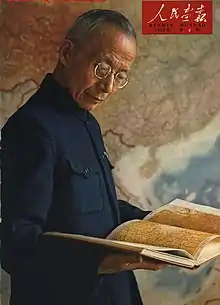
Motto
During the University Council meeting held in Yishan, Guangxi on 19 November 1938, "seeking truth" (Chinese: 求是; pinyin: Qiúshì) was made the motto of the university, upon President Chu Kochen's advice. Qiushi is an excerpt of the famous quote in Yangmingism, "A Gentleman learns only to know what is right. (Chinese: 君子之學,唯求其是)" It was made the name of the former body Qiushi Academy in 1897, which means seeking truth and has the same pronunciation as truth in English. According to Chu,
Seeking truth is not limited to studying hard or doing experiments in the lab. As Doctrine of the Mean says, seeking truth is 'to study extensively, inquire prudently, think carefully, distinguish clearly, and practice earnestly.'
In May 1988, "pursuing innovation" was added to the university motto by the university council, to adapt the motto to the times of reforms and opening up. President Lu Yongxiang explained in 1992,
Strictly speaking, pursuing innovation is included in seeking truth, [...] but people often regard seeking truth as being practical, emphasising the acknowledgement and application of the existing body of knowledge and the objective analysis and knowledge of the reality, with no emphasis on being creative and innovative.
Anthem
| External video | |
|---|---|
During the 19 November 1938 university council meeting, the neo-Confucianism scholar Ma Yifu, who was teaching at Chekiang was invited by President Chu to be the lyric writer of the university anthem, upon Chu's advice. However, as the lyric by Ma was written in Classical Chinese and thus difficult-to-understand, the anthem wasn't composed until Professor Ying Shangneng at National Conservatory of Music was invited to compose the anthem in the summer of 1941. In 2014, the Zhejiang University Anthem was ranked the most popular university anthem, according to an online survey by the news office of the Ministry of Education.[62]
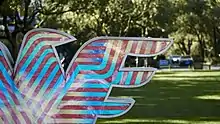
Mascot, logo and flag
The university's mascot is Qiushi eagle, which was first portrayed within its seal used by National Chekiang University during the 1920s and 1930s and then reintroduced in the 1990 logo of Zhejiang University.[63] The Qiushi eagle also appears in the logos of NingboTech University and Zhejiang University City College,[64][65] which was formerly affiliated institutions of Zhejiang University turned independent in December 2019.[63]
The current logo of Zhejiang University was introduced by the university council meeting in January 1991. The logo was officially digitized in May 2017.[66] The Chinese character calligraphy in the logo is taken from Mao Zedong's writing.[67] A combination of the calligraphy and logo in red or blue if using a blank flag or in white if using a blue or red flag is used as the flags of the university.[68]
Quotes of Chu Kochen
Chu Kochen, who served as the president of National Chekiang University from 1936 to 1949, is credited with a major impact on the guiding spirit of Zhejiang University.[69] His two open questions for the freshmen who enrolled in 1936 has been inscribed in the stone next to the main gate of the Zijingang Campus as well as multiple sites within the university, which says,[70]
You have two questions to ask yourself: First, what do you want to do at Zheda? Second, when you graduate, what kind of people do you want to be?
In another quote that is often displayed in the campus, Chu Kochen talks about the aim of university education, where he says,[71]
The aim of university education is not to nurture experts such as engineers and doctors, but to build leaders that are just, patriotic, fortitudinous and persistent, that take major roles, that lead trends, and that change the destiny of this nation.
Administration and organization
Governance
The university is organized according to Zhejiang University Chapter approved by the Ministry of Education of the People's Republic of China. The current chapter was approved in September 2014. According to the chapter, the university is a national university managed by the Ministry of Education and jointly funded by the central government and Zhejiang government. The university is operated by the Communist Party Committee of the university with the president taking the responsibility of decision making. The committee is required to ensure rule of law, academic freedom and democracy at the university.[72] Since 2000, the president and party secretary of the university are appointed by the Organization Department of the Chinese Communist Party, and the appointees are automatically considered as vice-ministerial level officials.[73] The party committee elects the members of the standing committee, which decide major issues at the university jointly with the party committee. The president hosts university council meeting to decide on teaching and learning, scientific research and administrative issues. The faculty can review and advise on university decisions via the faculty representative meeting.[72] The current party secretary of the university is Dr. Ren Shaobo. The president of the university is Professor Dr. Wu Zhaohui.[74]
Administrative departments
In the university has an administrative system that consists of 17 administrative departments. Among them, the Office of the Presidents set the strategic priorities for the university to maintain the university's leading position, while the Development and Planning Office is in charge of planning for the implementation of the strategic priorities. The Office of Global Engagement and the Division of Domestic Relations are responsible for implementing the university's strategy and promoting the university domestically and globally. The Human Resources Department recruits and provides services for the faculty, while the Undergraduate School and the Graduate School organise and supervise teaching, learning and degree awarding. The Administration of Continuing Education further provides training and supervision for continuing education programs. The research and development programs are supervised by the Sci-Tech Academy and the Academy of Humanities and Social Sciences, depending on the subject. The university research facilities and device are purchased, maintained, and evaluated by the Office of Laboratory and Equipment Management. The Department of General Affairs and the Office of Capital Construction are responsible for the management and construction of the university properties. The Medical Management Office manages the affiliated hospitals.[75]
Academic Structure
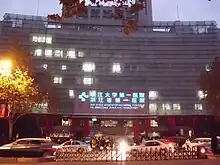
The academic disciplines at the university are divided into seven faculties, which each has different schools. Each faculty, school and department has its own academic committee and different rules of procedures. The committee is organized by the faculty, with a restriction on the percentage of people who serve administrative roles. Selection of the members are based on recommendations within the faculty. The university is a key comprehensive university whose fields of study cover eleven branches of learning, namely philosophy, literature, history, education, science, economics, law, management, engineering, agriculture, and medicine.[77] Below is the list of academic faculties, schools and colleges of the university:[78]
Faculty of Arts and Humanities
- School of Humanities
- School of International Studies
- College of Media and International Culture
- School of Art and Archaeology
Faculty of Social Sciences
- School of Economics
- Guanghua Law School
- College of Education
- School of Management
- School of Public Affairs
- School of Marxism
Faculty of Science
The Faculty of Science was a combination of the sciences departments at Hangzhou University and Zhejiang University
- School of Mathematical Sciences
- Department of Physics
- Department of Chemistry
- School of Earth Sciences
- Department of Psychology and Behavioral Sciences
Faculty of Engineering
- School of Mechanical Engineering
- School of Material Science and Engineering
- College of Energy Engineering
- College of Electrical Engineering
- College of Civil Engineering and Architecture
- College of Chemical and Biological Engineering
- Ocean College
- School of Aeronautics and Astronautics
- Department of Polymer Science and Engineering
Faculty of Information
The Faculty of Information consists of most key departments of Zhejiang University before the 1998 merger. The School of Software Technology was founded in 2001 and is located in both Hangzhou and Ningbo. Entry into the College of Computer Science and Technology is considered to be one of the most competitive in China. Its computer science department specialises in computer graphics, computer vision, and artificial intelligence, which are the computer science domains where Zhejiang University is ranked among top 5 worldwide according to CSranking. In the fourth round of CUSR, among the subjects that the faculty offers, Optical Engineering, Control Science and engineering, Computer Science and technology, and Software Engineering were rated A+, and Biomedical Engineering was rated A-.[79]
- College of Optical Science and Engineering
- College of Information Science and Electronic Engineering
- College of Control Science and Engineering
- College of Computer Science and Technology
- School of Software Technology
- College of Biomedical Engineering and Instrument Science
Faculty of Agriculture, Life and Environment Science
The Faculty of Agriculture, Life and Environment Science (FALE) consists of most departments of Zhejiang Agricultural University before the 1998 merger. In the fourth round of CUSR, among the subjects that the faculty offers, Agricultural Engineering, Horticulture, Agricultural Resources and environment, and Plant protection wer rated A+, Environmental Science and Engineering, and Pharmacy were rated A, Food Science and engineering, Crop Science, Animal Science were rated A-. It has the most subjects rated A-/A/A+ across all faculties at the university.[79]
- College of Life Sciences
- College of Biosystem Engineering and Food Science
- College of Environmental and Resource Sciences
- College of Agriculture and Biotechnology
- College of Animal Sciences
Faculty of Medicine
The Faculty of Medicine consists of most departments of Zhejiang Medical University before the 1998 merger, with their roots dating back to Chekiang Provincial Medical School founded in 1912, the Pharmaceutical Department of National Chekiang University founded in 1944 and the Medical School of National Chekiang University founded in 1945. The faculty used to be based at Hubin Campus until it is relocated to Zijingang in 2007. The School of Medicine is also among the 45 Chinese medical schools to offer English teaching Bachelor of Medicine and Bachelor of Surgery (MBBS) programs.[80] It also recruits medical doctoral students from prestigious Chu Kochen Honors College in a program named Ba Denian Medical Program. The School of Basic Medical Sciences offers a joint undergraduate programs in biomedicine and bioinformatics at International Campus. Under the School of Medicine, there are seven top-level hospitals. In the fourth round of CUSR, its clinical medicine, pharmacy and basic medicine are rated A+, A and A-, respectively.[79]
- College of Pharmaceutical Sciences
- School of Medicine
Under the School of Medicine, there are seven affiliated hospitals, including:[81]
- First Affiliated Hospital (as the first teaching hospital)
- Second Affiliated Hospital (as the second teaching hospital)
- Sir Run Run Shaw Hospital (as the third teaching hospital)
- Fourth Affiliated Hospital (also called Yiwu Hospital, as the fourth teaching hospital)
- Women's Hospital
- Children's Hospital
- Stomatology Hospital (also called Zhejiang Provincial Stomatology Hospital)
Finances
According to the University Chapter, the university is largely funded by the government.[72] The university has been selected into several national plans to nurture world-class universities, including Double First Class University Plan,[82][83] Project 985 and Project 211.[84] In 2022, with a budget of 26.1 billion Chinese yuan, the university had the second largest budget in China after Tsinghua.[85] The university also raises money through income from its affiliations, government subsidy, donations and other legal sources of income.[72] Zhejiang University consistently stands among top receivers of alumni donations in China. In 2021, it received 2.38 billion Chinese yuan, the fourth most after Tsinghua, Peking and Wuhan.[86] On September 21, 2006, Chinese billionaires Duan Yongping (Zhejiang University alumnus) and Ding Lei (Zhejiang native) donated together a one-time endowment of 40 million US dollars to Zhejiang University. US$30 million was from Duan with 10 million from Ding. It was the largest private one-off endowment to a university in Mainland China.[87] In 2017, the university received a donation of 1.1 billion Chinese yuan (circa.160 million US dollars), again breaking the record for highest alumni donation.[88]
Academics
Teaching and learning
The academic departments are responsible for teaching and assessments of various courses and draft the details of degree programs, which needs to be approved by the Undergraduate and Graduate Schools before start; the detailed method may differ according to the course and the program. Teaching is supervised and regulated by the Undergraduate School and the Graduate School for quality control. Chu Kochen Honors College (CKC), named after the university's former president Chu Kochen, is an elite undergraduate college of ZJU, which further select students from top students at ZJU or in Gaokao.[89][90][91] Teaching at Chu Kochen Honors College and international dual degree programs at Haining are supervised and regulated by their own responsible committees.
Degree awarding is based on academic credits requirement for compulsory and elective courses, which a student must both fulfill to graduate. To earn academic credits, the student can choose and pass a combination of courses at his or her will, as long as the course is available for enrolment,[92] yet some courses may be competitive for enrolment due to class size limits.[93]
Qiushi College
Qiushi College was founded in July 2008, as a residential college and part of the School of Undergraduate. It managed the student dormitories including the Danyang-Qingxi Hall, the Ziyun-Bifeng Hall, and the Lantian Hall. It offers liberal arts education for freshmen and supports student organizations and activities. It also provides students with aids for academic affairs such as college major choices and team building.[94] Upon enrolment into the university, undergraduates join a hall of Qiushi College at Zijingang mostly according to their faculties of study. In the student military training and education for all Chinese national freshmen, the students are organized according to their halls within the college. In the first year of study, the major of the student may be unspecified as they are recruited according to academic faculties rather than specific academic subjects. They are considered to be a student of the Hall but not of an academic department then. The student may later apply to study a major later or transfer to another major during the study, yet the application to popular majors are highly competitive and additional requirements may apply. The college is responsible for providing assistance to the student.[95]
Chu Kochen Honors College
Chu Kochen Honors College (CKHC) was founded in May 2000 in honour of Chu Kochen, a former president of the university and is typically chaired by the current president of Zhejiang University. Its predecessor the Mixed Class of Engineering was launched in 1984. It offers a collection of programs including the Experimental Class of Engineering, the Mixed Class, the Experimental Class of Humanities and Social Sciences, the Qiushi Sciences Class, the Experimental Class of Medicine, the Shennong Class.[96] Entry into the college is highly selective and competitive and its selection questions are known to be creative but difficult.[97][98] Notable alumni of the college include entrepreneur Colin Huang and the current president of Zhejiang University Wu Zhaohui.[96] Its teaching and learning are supervised by a special committee headed by the president. During the program, 15–20 percentile of the CKHC students in term of GPA will be transferred to non-CKHC programs.[71]
International Campus
The dual degree programs at the International Campus are supervised and regulated by the joint institute to fulfill academic requirements of both Zhejiang University and the partner institutes. For example, the University of Edinburgh regulations on progression and degree classification also applies to its joint institute at the campus, although they are not part of Zhejiang University regulations. The campus only provides a limited number of elective courses and allows students to elect a course that is not offered at his or her own institute. However, transfer from a Sino-foreign program to a purely ZJU program or between two programs of different joint institutes are not allowed. Transfer within the joint institute is allowed, yet its approval may be subject to the class size.
Research
Zhejiang University is a comprehensive research university. Research at Zhejiang University spans 12 academic disciplines: agriculture, art, economics, education, engineering, history, law, literature, management, medicine, natural sciences, and philosophy.
Among its approximate 4,191 standing faculty[99] members, more than 1,893 faculty members hold the title of professor. The faculty includes: 26 members of the Chinese Academy of Sciences, 27 members of the Chinese Academy of Engineering, 164 Chang Jiang (Yangtze River) Award winners, and 154 recipients of the awards from the National Science Fund for Distinguished Young Scholars. Zhejiang University also has prominent foreign faculty members. Zhejiang University has 11 State Key Laboratories, as one of the universities with most SKLs in China, which include:
- Rice Biology, State Key Lab of
- Chemical Engineering, State Key Lab of
- Modern Optical Instrumentation, State Key Lab of
- Industrial Control Technology, State Key Lab of
- Fluid Power Transmission and Control, State Key Lab of
- CAD and Computer Graphics, State Key Lab of
- Diagnosis and Treatment of Infectious Diseases, State Key Lab of
- Clean Energy Utilization, State Key Lab of
- Silicon Materials, State Key Lab of
- Plant Physiology and Biochemistry, State Key Lab of
- Modern Optical Instrumentation, State Key Lab of
The university also has three State Specialized Labs, including the State Specialized Lab of Secondary Resources Chemical Engineering, the State Specialized Lab of Power Electronics, and the State Specialized Lab of Biomedical Sensor. Besides, the university has three labs of the Ministry of Education (MOE), including the MOE Key Lab of Soft Soils and Geoenvironmental Engineering, the MOE Key Lab of Conservation Genetics and Reproductive Biology for Endangered Wildlife and the MOE-Microsoft Key Lab of Visual Perception.
Library system
The library system has a total library collection of more than 7.9 million volumes.[100] The system has 6 branch libraries, namely Yuquan Campus Library, Basic Library of Zijingang Campus, Library of Agriculture and Medicine of Zijingang Campus, Library of Ancient Books of Zijingang Campus,[101] Xixi Campus Library and Hujiachi Campus Library,[102] plus 3 branch libraries within different colleges, namely Guanghua Law School Library, International Campus Library, Ocean College Library.[103] Zijingang Campus is the only campus to have three library.[102] One can reserve a book at any library for collection of a book that may belong to another library in the system.[104]
Rankings
| University rankings | |
|---|---|
| Global – Overall | |
| ARWU World[105] | 33 (2023) |
| QS World[106] | 44 (2024) |
| QS Employability[107] | 35 (2020) |
| THE World[108] | 55 (2024) |
| THE Reputation[109] | 50 (2021) |
| USNWR Global[110] | 93 (2023) |
| Regional – Overall | |
| ARWU Asia[111] | 4 (2023) |
| QS Asia[112] | 5 (2021) |
| QS BRICS[113] | 5 (2019) |
| THE Asia[114] | 11 (2022) |
| THE Emerging Economies[115] | 3 (2020) |
| National – Overall | |
| BCUR National[116] | 3 (2019) |
| CUAA National[117] | 4 (2020) |
| Wu Shulian National[118] | 3 (2020) |
General rankings
Globally, ZJU is #33 in the Academic Ranking of World Universities 2023,[119] #44 in QS World University Rankings 2024,[120] #55 in the Times Higher Education (THE) World University Rankings 2024, and #93 in the USNWR 2022–2023.
China's MOE Evaluation
In the fourth round of China University Subject Rankings by the Ministry of Education released in 2018, ZJU had 31 subjects rated A and 11 subjects were rated A+.[79]
| Rating | Subjects |
|---|---|
| A+ |
Ecology • Optical Engineering • Control Science and Engineering • Computer Science and Technology • Agricultural Engineering • Software Engineering • Horticulture science • Agricultural Resource and Environment Sciences • Plant protection • Clinical Medicine |
| A |
Chinese Language and Literature • Foreign Language and Literatures • Mechanical Engineering • Materials Science and Engineering • Power Engineering and Engineering Thermophysics • Civil Engineering • Chemical Engineering and Technology • Environmental Science and Engineering • Management Science and Engineering • Pharmaceutical Science • Public Administration |
| A- |
Theoretical Economics • Theory of Marxism • Science of Law • Education • Mathematics • Physics • Chemistry • Biology • Electrical Engineering • Electronic Science and Technology • Biomedical Engineering • Food Science and Engineering • Animal Science • Crop Science • Basic Medicine • Business Administration • Design |
Student life
Student body
In June 2023, there were a total of 65,821 full-time students enrolled at Zhejiang University, including 29,117 undergraduates, 20,554 master's candidates and 16,150 doctoral candidates. In June 2023, there were 5,123 international students studying at Zhejiang University.
CC98 forum
CC98 is a student-run forum. It was created in December 2002.[121] It can be accessed by visiting www.cc98.org on the school intranet. It consists of categorical boards for discussion on various topics. As of March 2023, the forum is available only in Chinese.
Notable people
Students
See List of Zhejiang University alumni
- Li Qiang
- Cai Erjin
- Xi Mingze
- Chen Tianhua – Qiushi Academy and the member of Chinese United League and reporter of The People's Daily
- Chen Duxiu – the co-founder, the first General Secretary and first Chairman of Chinese Communist Party
- Xie Xuren – Minister of Finance of the People's Republic of China
- Hu Qiaomu – the first President of Chinese Academy of Social Sciences, President of Xinhua News Agency
- Huang Fu – President and Premier of the Republic of China
- Jiang Menglin – Minister of Education (1928–1930) of the Republic of China
- Chen Yi – Chief Executive and Garrison Commander of Taiwan
- Zhang Xinsheng – Chairman of UNESCO's Executive Board
- Ye Duzheng – meteorologist, State Preeminent Science and Technology Award winner 2005
- Xu Guangxian – chemist, State Preeminent Science and Technology Award winner 2009
- Hsiao-Lan Kuo – meteorologist, Carl-Gustaf Rossby Research Medal winner 1970
- Xie Xuejing – geochemist, AAG Gold Medal winner 2007
- Lin Fanghua – mathematician, Bôcher Memorial Prize winner 2002
- Hu Hesheng – mathematician, Noether Lecturer 2002
- Xu-Jia Wang – mathematician, Australian Mathematical Society Medal winner 2002
- T. Tony Cai – statistician, COPSS Presidents' Award winner 2008
- Tsung-Dao Lee – physicist, Nobel Prize laureate (physics, 1957)
- Chien-Shiung Wu – physicist, Wolf Prize laureate (physics, 1978)
- Xu Liangying – physicist, Andrei Sakharov Prize recipient 2008
- Chen Hang – horticulturist, Veitch Memorial Medal winner 1990
- Kun-Liang Guan – biochemist, MacArthur Award winner 1998
- Tao-Chiuh Hsu – biologist, the 13th President of American Society for Cell Biology
- Yao Zhen – biologist, the first President of Asian-Pacific Organization for Cell Biology
- Qiu Fazu – surgeon, Bundesverdienstkreuz recipient 1985
- Wu Guanzhong – painter, Ordre des Arts et des Lettres recipient 1991
- Lu Yongxiang – President of Chinese Academy of Science
- Ding Zhongli – Vice-president of Chinese Academy of Science
- Pan Yunhe – Vice-president of Chinese Academy of Engineering
- Pan Jiazheng – Vice-president of Chinese Academy of Engineering
- Wang Xufeng – writer, Mao Dun Literature Prize winner 2000
- Min Zhu – co-founder and former president and CTO of WebEx
- Cha Chi Ming – industrialist, entrepreneur, philanthropist, Grand Bauhinia Medal winner 1997
- Zhu Yanfeng – President of First Automobile Works
- Wang Jianzhou – Chairman & CEO of China Mobile
- Wang Tianpu – President of Sinopec
- Shi Zhengrong – Founder & CEO of Suntech Power
- Zhu Qinan – shooter, 10 m Air Rifle olympic champion, 2004 Athens
- Zhou Suhong – volleyball player, 2003 World Cup and 2004 Athens Olympic Games team champion.
Faculty
- Hailan Hu – laureate of the 2022 L'Oréal-UNESCO for Women in Science International Award
- Shing-Tung Yau – Fields Medalist, founder and director of the Center of Mathematical Sciences, Zhejiang University
- Shiing-Shen Chern – Wolf Prize laureate, former director and advisor of the Center of Mathematical Sciences
- Chien-Shiung Wu – Wolf Prize laureate
- Ren Mei'e – Victoria Medal winner 1986, former professor and dean of the Department of Geology
- Wu Wenjun – Shaw Prize laureate 2006, former teacher of Hangzhou University
- Liu Chen – Hannes Alfvén Prize recipient 2008, professor and director
- Su Buqing – mathematician, co-founder of Chen-Su School, former dean of the Department of Mathematics, former provost of Zhejiang University
- Chen Jiangong – mathematician, co-founder of Chen-Su School, former dean of the Department of Mathematics
- Bei Shizhang – biologist, former co-founder and professor of the Department of Biology
- Tan Jiazhen – geneticist, former professor of the Department of Biology, former dean of the College of Science
- Chang Chi-yun – historian, geologist, politician
- Coching Chu – meteorologist, geologist, former president of Zhejiang University
- Ma Yinchu – economist, former president of Zhejiang University
- Jiang Menglin – educator, former president of Zhejiang University
- Jin Au Kong – Electromagnetist, founder and former president of the Electromagnetics Academy
- Jin Yong – novelist, former dean of the Faculty of Arts and Humanities
- Qian Sanqiang – physicist
- Kan-Chang Wang – physicist, discover of the Sigma baryon, proposed neutrino detection which led to neutrino discovery, former dean of the Department of Physics
- Xia Yan – playwright, screenwriter
See also
Notes
References
- 校训. Archived from the original on December 25, 2016. Retrieved July 13, 2014.
- "Introduction to Zhejiang University". Archived from the original on December 25, 2016. Retrieved June 20, 2014.
- 学校数据与统计公报 [University Data and Statistical Bulletin]. Zhejiang University. Retrieved June 21, 2023.
- "Zhejiang University Logo and Mascot". Zhejiang University. Archived from the original on August 23, 2019. Retrieved August 23, 2019.
- ""Study at Zhejiang University"". Archived from the original on August 23, 2019. Retrieved August 23, 2019.
- ""Zhejiang University Facts and Figures"". Archived from the original on August 23, 2019. Retrieved August 23, 2019.
- "校情总览 – 历史沿革 School Overview – History". Zhejiang University. Archived from the original on October 17, 2023. Retrieved October 17, 2023.
- "浙大英语角狂人"潇洒哥"口语突飞猛进 _杭州网新闻频道". hznews.hangzhou.com.cn. Retrieved May 5, 2022.
- "接驳线公交站在哪里?沿途站牌"藏"得好 浙大学生和附近居民都说很难找". Hangzhou.com.cn. July 27, 2021. Archived from the original on July 27, 2021. Retrieved May 5, 2022.
- "浙大紫金港校区南门什么时候投入使用?最新消息来了". hangzhou.com.cn. February 24, 2022. Archived from the original on February 24, 2022. Retrieved May 5, 2022.
- "China's ugliest buildings: contest to celebrate unsightly architecture begins". the Guardian. September 20, 2021. Retrieved May 14, 2022.
- Oscar Holland. "'Ugliest building' competition spotlights China's latest bizarre architecture". CNN. Retrieved May 14, 2022.
- "Only In China – Country Launches Competition To Find The Ugliest Building In The Country". IndiaTimes. September 23, 2021. Retrieved May 14, 2022.
- "邵逸夫走了 浙江受邵逸夫基金之惠的学校有130余所-浙江新闻-浙江在线". zjnews.zjol.com.cn. Retrieved May 5, 2022.
- "浙大路获评全省绿化美化路". Xihu Net. February 11, 2022.
- "杭城记忆|求是村风雨60年". Zhejiang Online. July 9, 2015. Retrieved May 5, 2022.
- "蹭课蹭食堂蹭婚纱照外景 杭高校宽容对待"蹭客"-搜狐教育". learning.sohu.com. Archived from the original on May 9, 2022. Retrieved May 5, 2022.
- "财智汇:浙江高校卖地记". 腾讯大浙网_腾讯网. September 5, 2013. Archived from the original on March 25, 2015. Retrieved May 5, 2022.
- "全国干部教育培训浙江大学基地|华家池校区的古往今来_培训动态_浙江大学". Zhejiang University. Archived from the original on December 4, 2020. Retrieved May 5, 2022.
- "浙大之江校区钟楼重新开放 这里可以眺望钱塘江江景". Qianjiang Evening News. December 21, 2016. Archived from the original on May 5, 2022 – via Tencent News.
- "海洋学院英文网". oc.zju.edu.cn. Archived from the original on September 21, 2021. Retrieved September 21, 2021.
- "听过"校歌""校服",你听过"校船"吗?". Zhejiang Online. Retrieved May 5, 2022.
- "Faculty and Staff Moved to Haining Campus | International Campus Zhejiang University". www.intl.zju.edu.cn. Archived from the original on October 12, 2016. Retrieved October 12, 2016.
- "浙大海宁国际校区明年投入使用". 杭州网. May 21, 2015. Archived from the original on March 27, 2020. Retrieved January 20, 2018.
- "浙江大学海宁国际校区正式启用——建筑设计院交出一份满意的答卷". 浙江大学. August 23, 2016. Archived from the original on March 5, 2017. Retrieved January 20, 2018.
- "徐立之出任浙江大学国际校区书院首任院长". Zhejiang University. September 18, 2016.
- "Prof. Lap-Chee Tsui Appointed as Inaugural Dean of Residential College on International Campus". Zhejiang University. September 18, 2016.
- "Lap-Chee TSUI – Our Members". The Hong Kong Academy of Sciences. Archived from the original on March 3, 2022. Retrieved May 5, 2022.
- "Introduction". The library of International Campus Zhejiang University. Archived from the original on April 7, 2019. Retrieved May 5, 2022.
- 朱蓓蕾; 李科; 杨怡微 (August 13, 2020). "离开通又近一步! 杭海城际铁路全线"轨通"". 杭州网 (in Chinese). 杭州日报. Archived from the original on July 8, 2021. Retrieved July 8, 2021.
- "Hangzhou-Haining intercity railway". zhejiang.chinadaily.com.cn. July 9, 2020. Archived from the original on July 16, 2021. Retrieved July 16, 2021.
- "Zhejiang-Hanghai Intercity Railway was completed and opened to traffic". Seetao. July 2, 2020. Archived from the original on July 18, 2021. Retrieved July 16, 2021.
- "NUS Business School and Zhejiang University International Business School signs MOU for academic collaboration". NUS Business School. October 13, 2021. Archived from the original on October 13, 2021. Retrieved May 5, 2022.
- O'Meara, Sarah (May 30, 2018). "China's Zhejiang province is open for science business". Nature. 557 (7707): S51–S52. Bibcode:2018Natur.557S..51O. doi:10.1038/d41586-018-05265-z. PMID 29849161. S2CID 44066258. Archived from the original on March 5, 2022. Retrieved May 5, 2022.
- "About the partnership". The University of Edinburgh. Archived from the original on February 16, 2022. Retrieved May 5, 2022.
- "About | UIUC-ZJU Partnership". Grainger Engineering Office of Marketing and Communications. Archived from the original on September 24, 2021. Retrieved May 5, 2022.
- "欢迎同学们!宁波地铁直达你的大学 攻略在此-新闻中心-中国宁波网". news.cnnb.com.cn. Archived from the original on September 2, 2021. Retrieved May 5, 2022.
- "校区简介". nb.zju.edu.cn. Archived from the original on January 21, 2021. Retrieved May 5, 2022.
- "发展历程". nb.zju.edu.cn. Archived from the original on January 22, 2021. Retrieved May 5, 2022.
- "浙江大学智能创新药物研究院". www.zjuaim.com. Archived from the original on January 4, 2022. Retrieved May 5, 2022.
- "ZIII简介-浙江大学国际创新研究院". www.zii-china.org. Retrieved May 5, 2022.
- "Introduction". iibms.zju.edu.cn. Retrieved May 5, 2022.
- "浙江大学温州研究院官网". www.zjuiwz.com. Retrieved May 5, 2022.
- "历史沿革". Research Institute of Zhejiang University – Taizhou.
- ""两院"概况". Zhejiang University Institute of Quzhou.
- "浙江大学金华研究院来了!". kjt.zj.gov.cn. Retrieved May 5, 2022.
- "浙江大学湖州研究院正式揭牌". College of Control Science and Engineering, Zhejiang University. January 16, 2021. Archived from the original on March 2, 2021. Retrieved May 5, 2022.
- "浙江大学国际健康医学研究院". International Institutes of Medicine. Archived from the original on March 8, 2022. Retrieved May 5, 2022.
- "官宣!绍兴牵手浙江大学,重量级研究院签约". m.shaoxing.com.cn. Retrieved May 5, 2022.
- "中心简介". Ocean Research Center of Zhoushan. Archived from the original on May 16, 2021. Retrieved May 5, 2022.
- "浙江大学北京研究院". bj.zju.edu.cn. Archived from the original on May 1, 2022. Retrieved May 5, 2022.
- "浙江大学上海高等研究院". sias.zju.edu.cn. Archived from the original on March 8, 2022. Retrieved May 5, 2022.
- "浙江大学海南研究院". www.hnyjy.zju.edu.cn. Archived from the original on March 9, 2022. Retrieved May 5, 2022.
- "网站首页 – 浙江大学深圳研究院". zjusz.com. Archived from the original on March 14, 2022. Retrieved May 5, 2022.
- "浙江大学苏州工业技术研究院". www.zjuszgyy.com. Archived from the original on March 31, 2022. Retrieved May 5, 2022.
- "浙江大学常州工业技术研究院". www.zjuczgyy.com. Archived from the original on January 2, 2022. Retrieved May 5, 2022.
- "浙江大学中原研究院". www.zjdxzyyjy.cn. Archived from the original on May 14, 2021. Retrieved May 5, 2022.
- Hsieh, Chiao-min (2009). Race the rising sun : a chinese university's exodus during the second world war. Jean Kan Hsieh. Lanham, MD: Hamilton Books. ISBN 978-0-7618-4268-2. OCLC 371501171.
- "浙大官方回应:目前没有恢复重建浙大遵义校区的打算 | 早报". Lianhe Zaobao (in Simplified Chinese). March 12, 2018. Archived from the original on March 12, 2018. Retrieved May 5, 2022.
- ""浙江大学湖滨校区"成历史名词". 杭州网. January 5, 2007. Archived from the original on November 10, 2012.
- "浙大原湖滨校区将变身为豪华商业酒店中心". 东方网. October 22, 2007. Archived from the original on March 4, 2016.
- "高校十大校歌排名出炉 浙大文言校歌登榜首". Yangtse Evening Post. April 30, 2014. Archived from the original on July 22, 2020. Retrieved May 1, 2022 – via Sina Education.
- Yue, Huairang (December 6, 2019). "两所浙江大学为母体的独立学院转设拟获批,校名均冠"浙大"". The Paper. Archived from the original on May 9, 2022. Retrieved May 7, 2022.
- "浙大城市学院 学校标志". Zhejiang University City College. Archived from the original on January 8, 2022. Retrieved May 7, 2022.
- "学校标识". NingboTech University. Archived from the original on November 3, 2021. Retrieved May 7, 2022.
- "校情总览". Zhejiang University. Archived from the original on October 29, 2021. Retrieved May 7, 2022.
- "我的大学,是谁的手迹装点了你的门楣?". China Youth Daily Online. May 2, 2017. Archived from the original on May 9, 2022. Retrieved May 7, 2022.
- "校情总览". Zhejiang University. Archived from the original on May 9, 2021. Retrieved May 7, 2022.
- "A visit of culture". The State Council, People's Republic of China. November 23, 2014. Archived from the original on May 9, 2022. Retrieved May 7, 2022.
- "竺可桢:跨越两个世纪 浙大老校长的求是一生". people.cctv.com. Retrieved May 1, 2022.
- "公忠坚毅能担大任 老校长的话一直挂墙上". Qianjiang Evening News. May 11, 2017. Archived from the original on May 9, 2022. Retrieved May 6, 2022 – via Phoenix Network.
- "中华人民共和国教育部高等学校章程核准书第28号(浙江大学) – 中华人民共和国教育部政府门户网站". www.moe.gov.cn. Archived from the original on August 13, 2016. Retrieved May 5, 2022.
- "中管高校是啥?985高校中只有这8所不是中管高校!". 鳳凰網. August 29, 2017. Archived from the original on May 13, 2019. Retrieved March 3, 2019.
- "University Leadership". Zhejiang University. Archived from the original on March 2, 2022. Retrieved May 6, 2022.
- "Administrative Units". Zhejiang University. Archived from the original on March 2, 2022. Retrieved May 6, 2022.
- "2020年度全国医院综合排行榜". Hospital Management Institute, Fudan University. November 20, 2020. Archived from the original on April 24, 2022. Retrieved May 6, 2022.
- "Zhejiang University". CUCAS. Archived from the original on August 26, 2015. Retrieved August 24, 2015.
- "Academic Structure". www.zju.edu.cn. Archived from the original on March 2, 2022. Retrieved September 22, 2021.
- "China University Subject Rankings (CUSR)". China Academic Degrees and Graduate Education Development Center. Archived from the original on April 27, 2022. Retrieved April 24, 2022.
- "Why China limits English-taught MBBS to 45 universities – Times of India". The Times of India. Archived from the original on May 6, 2022. Retrieved May 6, 2022.
- "Hospitals". Times Higher Education (THE). June 8, 2017. Archived from the original on November 6, 2021. Retrieved May 7, 2022.
- 教育部 财政部 国家发展改革委 关于公布世界一流大学和一流学科建设高校及建设 学科名单的通知 [Notice from the Ministry of Education and other national governmental departments announcing the list of double first class universities and disciplines]. Ministry of Education. Archived from the original on March 27, 2019. Retrieved June 19, 2018.
- "The universities and disciplines China aims to turn into world-beaters". South China Morning Post. February 15, 2022. Archived from the original on May 4, 2022. Retrieved May 4, 2022.
- "Retaking the test: can China's universities secure 'world-class' status at third attempt in two decades?". South China Morning Post. August 28, 2016. Archived from the original on May 4, 2022. Retrieved May 4, 2022.
- "2022年全国高校经费统计结果出炉". sohu. Retrieved September 16, 2022.
- "中国高校校友捐赠最新排名出炉,武大30.43亿挺进前三". 科学网. Archived from the original on January 23, 2022. Retrieved May 2, 2022.
- 网易新闻中心:段永平、丁磊4000万美元捐赠浙江大学 [Duan Yongping and Ding Lei donates 40 million US dollar to Zhejiang University]. 163.com news. September 21, 2006. Archived from the original on May 2, 2019. Retrieved April 5, 2011.
- Hu, Yijing (May 6, 2017). "Biggest alumni donation in China's history for Zhejiang University". China Plus. Archived from the original on May 2, 2022. Retrieved May 2, 2022.
- Ryan, Janette (March 7, 2011). China's Higher Education Reform and Internationalization. Taylor & Francis. ISBN 978-1-136-90811-8. Archived from the original on May 5, 2022. Retrieved April 24, 2022.
- Ye, Jing-Jia; Qiu, Li-Min; Tang, Xiao-Wu (October 20, 2017). "Interdisciplinary Learning: A Strategy of Chinese Honors Education for providing depth and scale of learning". Journal of the European Honors Council. 1 (2): 1–4. doi:10.31378/jehc.13. ISSN 2543-232X. Archived from the original on November 24, 2020. Retrieved April 25, 2022.
- Li, Yan; Chen, Xinya; Chen, Yixuan; Zhang, Fan; Sallam, Marwan H. (2021). "Investigation of College Teachers' TPACK Level During the Epidemic Situation: Taking Chu Kochen Honors College, Zhejiang University as an Example". 2021 IEEE 24th International Conference on Computer Supported Cooperative Work in Design (CSCWD). pp. 480–484. doi:10.1109/CSCWD49262.2021.9437867. ISBN 978-1-7281-6597-4. S2CID 235235686. Archived from the original on April 25, 2022. Retrieved April 25, 2022.
- "浙江大学关于印发《浙江大学学分制管理暂行规定》的通知" (PDF). Zhejiang University. December 10, 2008. Archived (PDF) from the original on May 9, 2022. Retrieved May 5, 2022.
- "选课常见问题解答" (PDF). Zhejiang University. Archived (PDF) from the original on July 13, 2019. Retrieved May 5, 2022.
- "学院简介". qsxy.zju.edu.cn. Archived from the original on September 19, 2020. Retrieved May 5, 2022.
- Wu, Xiaocheng (April 1, 2020). 引路——浙江大学求是学院的思考与实践 (in Chinese). Zhejiang University Press. ISBN 9787308198813.
- 新财富杂志. "清华姚班VS浙大竺院,谁是中国最牛AI创业班?". www.huxiu.com. Retrieved May 5, 2022.
- "浙大竺院昨天进行选拔笔试 考题接地气、有创意". edu.zjol.com.cn. Retrieved May 5, 2022.
- "一道《长安十二时辰》考题难倒不少"学霸"浙大最牛"竺可桢学院"开考_杭州网". ori.hangzhou.com.cn. Archived from the original on August 12, 2019. Retrieved May 5, 2022.
- "Facts and Figures of Zhejiang University". Archived from the original on August 23, 2019. Retrieved August 23, 2019.
- 搜狐网 – 高校门户网 – 浙江大学. Sohu Education. Archived from the original on May 11, 2008. Retrieved May 11, 2008.
- "Library of Ancient Books opens at Zhejiang University". Zhejiang University. May 30, 2021.
- "分馆". libweb.zju.edu.cn. Archived from the original on April 20, 2022. Retrieved May 5, 2022.
- "院系分馆". libweb.zju.edu.cn. Retrieved May 5, 2022.
- "Reader's Guide" (PDF). Zhejiang University International Campus Library.
- "ShanghaiRanking's Academic Ranking of World Universities". www.shanghairanking.com. Retrieved August 15, 2023.
- "QS World Zhejiang University Ranking 2024". Retrieved August 19, 2023.
- "Ger 2020". Archived from the original on June 23, 2020. Retrieved December 11, 2019.
- "THE World University Rankings 2024". September 2, 2021. Archived from the original on April 6, 2022. Retrieved September 2, 2021.
- "THE Reputation World University Rankings 2021". October 27, 2021. Retrieved October 27, 2021.
- "Zhejiang University". Retrieved August 19, 2023.
- "ShanghaiRanking's Academic Ranking of World Universities". www.shanghairanking.com. Retrieved August 15, 2023.
- "QS University Rankings: Asia 2021". Archived from the original on November 30, 2019. Retrieved November 27, 2020.
- "Zhejiang University". Top Universities. Archived from the original on August 7, 2019. Retrieved August 7, 2019.
- "THE Asia University Rankings 2022". June 1, 2022. Archived from the original on May 13, 2019. Retrieved June 2, 2022.
- "THE Emerging University Rankings 2020". January 22, 2020. Archived from the original on February 20, 2020. Retrieved November 27, 2020.
- "Best Chinese Universities Ranking • Overall Ranking – 2019". Archived from the original on April 25, 2022. Retrieved May 2, 2022.
- "First Class Universities in China Ranking – 2020". Sohu. Archived from the original on February 2, 2020. Retrieved May 25, 2019.
- "Chinese Universities Ranking Wushulianl Wushulian Ranking – 2020". Sohu. Archived from the original on October 22, 2020. Retrieved March 5, 2019.
- "ShanghaiRanking's Academic Ranking of World Universities". www.shanghairanking.com. Retrieved August 15, 2023.
- "QS World University Rankings 2023: Top Global Universities". Top Universities. Retrieved August 15, 2022.
- "cc98上的考试季_教育频道_凤凰网". February 23, 2018. Archived from the original on February 23, 2018. Retrieved March 5, 2023.
External links
- Zhejiang University Home Page (in English)
